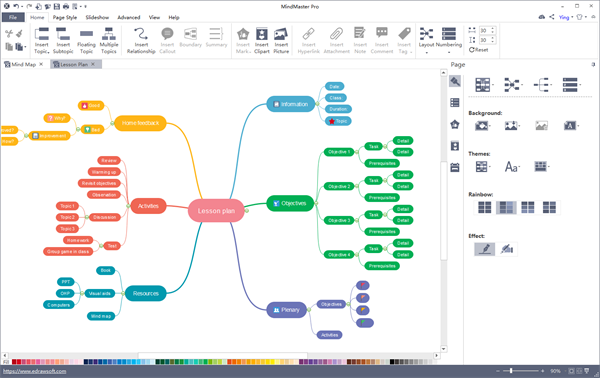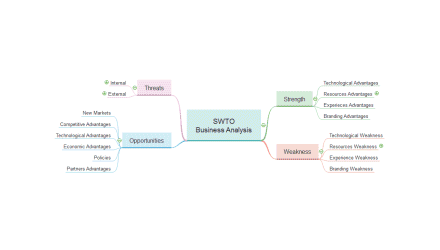EdrawSoft levert nieuwe mind mapping software
voor jullie gevonden op Biggerplate
Exciting new entrant reflects key questions for mind map sector

Last month saw the launch of a new stand-alone mind mapping application called Edraw MindMaster from the team at EdrawSoft who have been developing diagram/drawing software solutions since 2014. While a few eyebrows and comments may be raised in relation to the name of the product, this is perhaps detracting/distracting from what we think are broader and more interesting questions that this new entrant to the mind mapping sector may reflect…
Edraw MindMaster: First Impressions
This article is not a software review, but it’s worth saying that the Edraw MindMaster tool itself is impressive. People with experience of Windows-friendly tools like MindManager, ConceptDraw, XMind and iMindQ will most likely find the Edraw MindMaster experience feeling familiar and easy. Menus look similar to other tools, work as you’d expect, and the software has some nice options when it comes to map themes, design, and presentations.

A sign that the company knows the essentials of the market that it’s getting into is the fact that Edraw MindMaster can import both MindManager and XMind software formats, and also export back to MindManager format. We’re often surprised to see new mind mapping products launch without any ability to import existing mind map file formats, and it’s therefore encouraging and intelligent for Edraw to have this in place from the start. It may be reasonable to expect other popular formats to be included in the future if this initial set is anything to go by.
Overall, the free version of Edraw MindMapper is a very capable product, and may already eclipse some of the older and weaker desktop software products in the market. The ‘pro’ version adds some nice additional functionality, including a ‘hand-drawn’ style of map, and more editing/formatting options that will appeal to sections of our member community who like to add visual interest to their maps. There’s also an HTML export option that at present creates a static view, but in the future is likely to get a little more interactive, and this may be of interest to users wanting to share maps, as well as a few other developers in the space.
All that being said, something strangely lacking from the application is the ability to ‘grab’ the map (using the mouse) in order to move it around as a means of navigating the content. When working with mind maps, we’d consider this a fundamental feature that’s pretty universal across applications. As someone who uses this method of navigation heavily, I found this strangely disorienting, but it’s possible I may have missed something, or there’s an early release bug!
Questions for the sector
While the Edraw MindMaster software itself is impressive, we are (as always) looking at this new product launch in the context of the broader mind mapping sector in which we operate, and considering what possible implications and opportunities it may represent. We think this particular software launch (more than most) poses some interesting questions for consideration…
A new (potentially) big player?
At Biggerplate we maintain a Software/App Radar, which is a connected set of internal tools and records that help us monitor and keep track of what’s happening across the mind mapping world. The ‘radar’ currently tracks about 50 mind mapping software applications, some of which are big names and larger companies, and some of which are small independent developers.

Some names on the radar might be considered ‘pure’ mind mapping tools, while others may not be mind mapping tools as such, but have mind mapping functionality embedded within them (in itself, an interesting and growing trend). While many members of our community may not have heard of EdrawSoft previously, the company has been on our radar for some time, as their Edraw Max product has featured a capable (embedded) mind mapping function for several years. The arrival of a stand-alone Edraw mind mapping product is not much of a surprise from our perspective, given that almost every core diagram function of Edraw Max has previously been spun out into an individual product offering (e.g. Flow Charts, Org Charts etc). However, we think what’s important to note here is not just what has been launched, but who has launched it.
While new mind mapping products pop up every few months within the mobile app environment, they are often from hobbyist developers, or very small development teams exploring possibilities on an iPad or similar. Many never develop beyond the initial basic product, and some disappear almost as quickly as they appear. New entrants in the desktop software space are less common, and in that sense the arrival of Edraw MindMaster is already somewhat unusual, but what’s even more unusual is a new mind mapping product arriving with such an established company and brand behind it.
Edraw MindMaster is a product being launched by a company with some resources, and you can see this in the polish of the new product, even if you did not know anything else about the company behind it. But… to share just one indicator from our Software/App Radar, you might be interested to know that the EdrawSoft website has a better Alexa ranking (an indicator of website traffic and popularity) than 4 out of the top 5 ranked tools in our Mind Mapping Software Directory. This does not of course indicate or guarantee a strong mind mapping software product, but it does serve to illustrate that this is a mind mapping tool being launched from a strong foundation.
So, the question is whether we are seeing the arrival of a new player in the mind mapping space, and possibly one that has the potential to be a ‘big’ player? Obviously it’s very early days, and only time will tell. However, I’d suggest others in the sector might need to tune up their own radars, as I’m sure a number of them will have zero awareness of this new player prior to today…
Successful “Freemium” mind mapping?
Edraw MindMaster has launched with a ‘Freemium’ model in place, where a limited version of the software is available to download and use free of charge, while a more feature-rich ‘Pro’ version is available for between $69–$145 depending on what level of upgrade protection you desire.
While there are some mind mapping developers operating with a Freemium model, the option of giving a way a (limited) free version, and holding back key features for paying users is not actually that common within the sector.

Undoubtedly there are advantages and disadvantages to this approach. While ‘Free’ often attracts awareness and large user numbers, it is often very difficult to distinguish which of the resulting mass of users are ever likely to pay for upgraded features, and even harder to get them to actually do it. If the paid version of an app cannot generate sufficient revenue, then development and improvement of the app overall will suffer, as there is little revenue to invest in further development, and little motivation to do so. In the end, free tools that are not effective in converting people into paying users will eventually run out of steam and stall.
That being said, it’s all a matter of time and tweaking. If you can afford to sustain a loss-making Freemium model while you continually test and refine your conversion tactics, then you may eventually find the sweet spot that enables you to sustain a large ecosystem of free users, in addition to a growing and profitable segment of paying users. How long it takes to find the ‘sweet spot’, and how long you can fund your experimentation, are obviously the key questions that underpin a Freemium model.
This brings us back to the EdrawSoft company, and what has already been discussed. With an established brand, software business and user base, it’s possible that EdrawSoft is in a strong position to run Edraw MindMaster as a freemium product, either because they already know the sweet spots and have a proven/viable model established through their existing products, and/or because they have a resource buffer that enables them to attract users with a free product offer whilst figuring out the best ways to convert them into paying users. In either case, it’s possible that the attraction of a strong free product may be enough to attract new users to mind mapping, but may also test the product loyalty of some existing mind mapping software users.
Increasing Chinese influence?
Not mentioned up until this point is the fact that EdrawSoft is a Chinese company, based in the tech city of Shenzhen (also home to the brilliant XMind team, and a few other companies on our radar). The emergence of a strong new mind mapping product from a Chinese company is further evidence (if any were needed) that the mind mapping sector, like all others, is likely to be heavily influenced by China in the coming years, both in terms of consumer demand for mind mapping software/apps, and in terms of the companies driving development and innovation of these tools.
Over the previous decade or two, the Mind Mapping space has been largely dominated by Europe and the US in terms of software development and thought leadership around the topic of mind mapping/visual thinking. As a result, most of the leading mind mapping software companies come from, and largely cater to, North American and European markets. However, with the broader geo-political and commercial shifts happening globally, and the increasing prominence of China generally, the not-too-distant is likely to look quite different for the mind mapping sector.

We can certainly be confident that China will exert an ever-greater influence on the mind mapping community in the coming years, and become a huge driver of its evolution. The role and impact for companies like Biggerplate, North American and European software developers, and even the local Chinese companies in this future is unclear. While many of the established Western developers will be looking towards China and considering how to approach this large but complicated market, it’s worth considering that the growing number of software players in China are not only looking in the opposite direction (towards Europe & particularly the US), but are also well-established within their domestic market. The high profile struggles of large billion dollar companies like Uber in their efforts to break into the Chinese market serve as cautionary tales for anyone developing a ‘China Strategy’, but many of the same challenges will apply to Chinese firms trying to break into European and North American markets. It will therefore be interesting to see in the years to come which Western companies take the biggest steps into China, and which Chinese companies are most successful in stepping outside of their enormous domestic market.
From a Biggerplate perspective, we are fortunate to have had some great experience and exposure in China despite our small size as a company. This has been enabled through our fantastic partnership with XMind, combined with ever-increasing engagement from our Chinese members, and a unique opportunity to deliver our live mind mapping services earlier this year in Shanghai. We look forward to welcoming many more Chinese mind mappers to the Biggerplate community in the near future, but to do so we must ensure we’re as ready as possible for these changes and developments as they accelerate. Ensuring both our ‘Radar’ and relationships are as strong as possible will be vital for us, and (I’d suggest) for others too…
We’re delighted to welcome our friends at EdrawSoft to the mind mapping arena, and look forward to all the possibilities that this may bring!